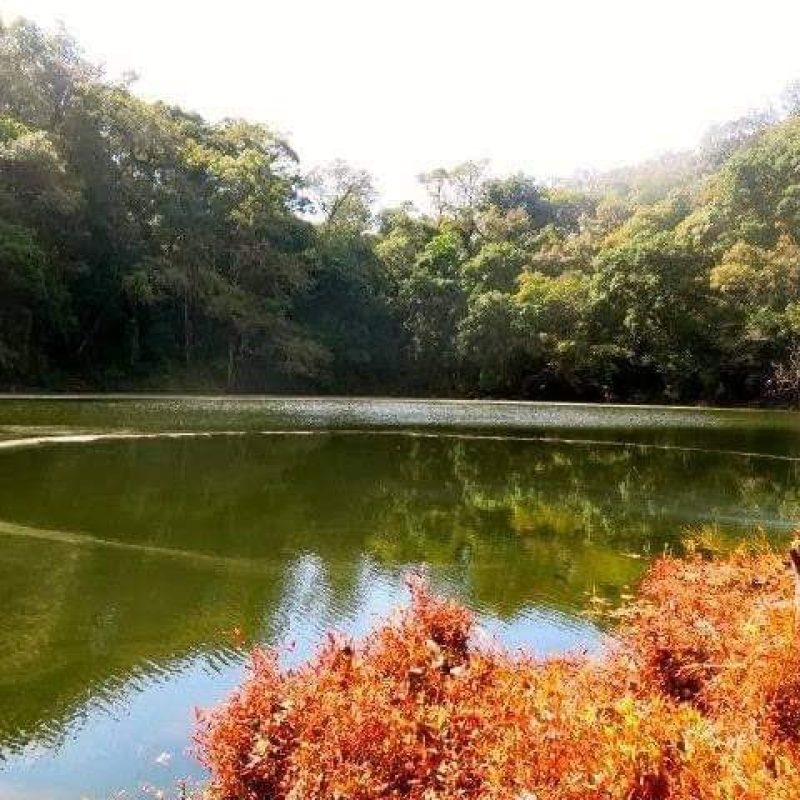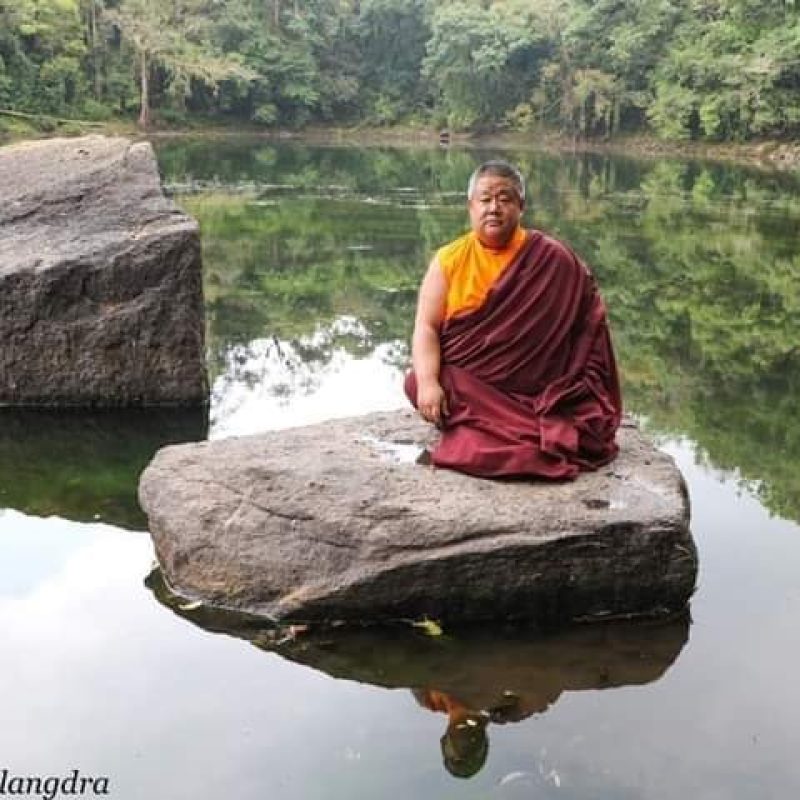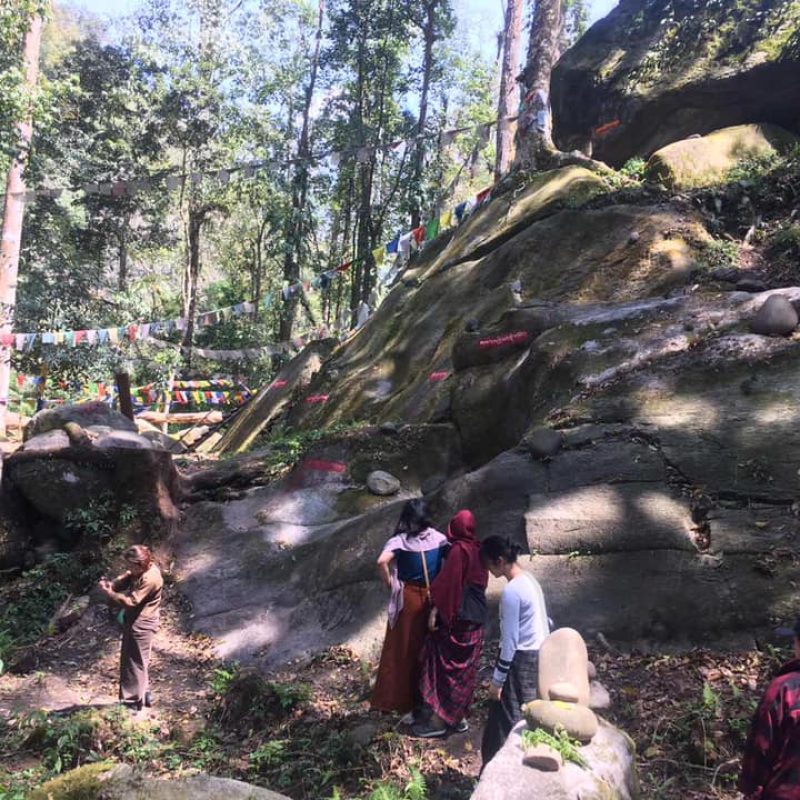Sacred Buli Tsho ( Lake)
Zhemgang, Eastern
BUILT : 0000
Tshomen Kuntu Zangmo commonly known as Buli Menmo is believed to be the deity of the Buli Tsho (Lake). The Buli lake is situated in the heart of a thick forest covering an area of 4.4 acres at a place called Baer-pang, south of Kheng Buli. It is 5k away from the gewog center and takes about 15 minutes by car, and 30 minutes on foot through a short cut.  The deity Tshomen Kuntu Zangmo is represented in a fully zoomorphic form—half human body with many hooded snake canopy over her head and lower part of the body below the navel coiled like a snake. Her human form is beautifully adorned with brocade, ornaments of turquoises, pearls, corals, and a floral wreath on her forehead. A She is believed to be semi-divine, who can bestow wealth, health, prosperity, and also protect from misfortunes and illnesses if people worship her.
An oral source asserts that Tshomen Kuntu Zangmo is destined to be at Kheng Buli. Her date of arrival at Kheng Buli is not known; however, legend has it that she came from the northern Shambala region of Tibet. From Tibet, she wandered through Kurtoe Dungkar in Lhuntse, then travelled through Tang Kuenzang Drak and reached Zhuri in Bumthang, where she is believed to have rested and breastfed her child. From Zhuri, she wandered through a dense forest and entered the region of Kheng Buli, crossed the peak of Braetikya and descended into the valley of Bouth Gang, where she again took rest and breastfed her child. At Bouth Gang, she disguised as an old woman and traveled to the house of Trongmeth. When she reached the house of Trongmeth, she saw a grandmother and requested her for shelter. The grandmother gave a room to stay, but Tshomen requested that she would like to stay in the choesham, the altar room. Before she went to take rest, she requested the grandmother not to disturb her until the next morning.
The next morning, the disguised Tshomen did not wake up even at 8 o clock in the morning. So, the grandmother got worried and she peeped through a small hole from the next room to see what had happened to her guest. To her astonishment, she saw thousands of snakes sleeping and on the top was a snake with horns and turquoise on her forehead, and it was making a hissing sound. After some time, the old woman woke up and came towards the grandmother and said, told you not to peep through the hole but you didnt listen, and with those words, she left the grandmothers house. After that, the grandmother went inside the altar room and found a white turquoise. The turquoise was a gift from the Tshomen, and so it is said that the grandmother’s cattle multiplied. However, some years later the grandmother apparently lost the turquoise and from then onwards the number of cattle dwindled day by day.
Oral narrative has it that after Tshomen left the house of Trongmeth, she is believed to have laid claim of the adjoining places of Langbi and Zelwakha, and established her phodrang (palace) in the form of a lake that covered an area of 13 acres of land. During her stay at the place, people kept throwing corpses of dogs and horses and polluted her lake. From there, she moved to Baerpang, which is 5k away from the village and settled below a paddy field. However, people passing by caused her a lot of disturbances and polluted her. She then moved the lake to a safe and secret place that covered an area of 4.4 acres of land, hidden deep in the thick forest of Kheng Buli. That place became a permanent phodrang for the Tshomen.
Next to Tshomen, there is a small lake called Gorapa”the gatekeeper of Tshomen. It is said that in the past, one had to visit the Gorapa lake first, and then visit Tshomen. People say that Gorapa will allow only those who are not defiled to visit the Tshomen. If one is defiled, Gorapa will make a sound, which is a signal that one should not visit Tshomen.
Besides, in the surrounding area of Baerpang and in the four directions of the Tshomen Kuntu Zangmo there are 105 small lakes, and they are believed to be the retinues of Tshomen. A There are many rock outcrops that are believed to be the temple, shopkeeper, dog, snake, rooster, handloom, and horse of Menmo. Amazingly, there are 108 white birds known as Phigsangma, or the sweeper, who cleans and sweeps away the leaves from the surface of the lake every morning.
Today, visitors from around the country visit the Tshomen daily because of easy accessibility by road. In the past, Terton Pema Lingpa (15th century) and Terton Dorji Lingpa (12th century) are believed to have visited the lake and blessed the Menmo. Later, Ponlop Khen Rinpoche, Lama Gyalwai Nima, His Holiness Tulku Jigme Choedra, His Eminence Namkhai Nyingpo Rinpoche, His Eminence Gangteng Tulku Rinpoche, Peling Sungtrul Rinpoche, Kyabji Thuksey Rinpoche, and Kathok Situ Rinpoche had also visited the Tshomen.
Furthermore, in 2014, His Majesty king Jigme Khesar Namgyel Wangchuk commissioned and presented the portraits of Menmo Kuntu Zangmo and Rongla Lha-Tsen Karpo to Bar-lhakhang. His Majesty also commanded the local people to construct a Lu-Khang nearby the lake, and presented a gold-engraved Menmo on a slate to be placed inside the Lu-Khang.
In 2016, Bhutan Trust Fund installed a fencing around the lake to protect and safeguard the Menmo. Today, the community has appointed a caretaker and he is responsible for collecting entry fees of Nu. 30 from the local people, and Nu. 100 from foreigners. The money collected from the visitors is used to make offerings to Tshomen twice a year.
Social and Cultural Significance
Tshomen Kuntu Zangmo is one of the main protective deities of the people of Kheng Buli. They make offerings to Tshomen twice a year. Firstly, on the 15th day of the 5th month of the Bhutanese calendar. Farmers mainly invoke Menmo to seek protection for their crops from wild boars, animals, insects, and worms. They also pray for the abundance of rainfall and sunshine, especially during the time of paddy transplantation.
Secondly, on the 15th day of the 10th month, offerings are made mainly to pay gratitude to Menmo for protecting their crops from the wild animals and natural calamities, and also for giving them a good harvest.
Besides, Menmo Kuntu Zangmo is worshipped during community celebrations like Tsechus, rituals, festivals, and annual Loche. Everyone invokes her so that they are blessed with luck, fortune, name and fame, longevity, and fulfillment of ones aspirations.
Belief System
People believe that one should not visit Tshomen wearing the clothes of deceased persons, the woman at the time of menstruation, and when there is a defilement of birth and death in the village. It is said that it will pollute the Tshomen.
The community strictly prohibits people from visiting the Tshomen from the first day of the 8th month till the 15th day of the 10th month of the Bhutanese calendar every year. It is done so to avoid polluting the Tshomen. If otherwise, it is said that she will cause lots of destruction and rampage in the community by bringing heavy rainfall, lightning and thunderstorm, and hailstone, which destroy the crops and kill the domestic animals.
Furthermore, visitors must be in the national dress when they visit the Tsho, or the lake. People are prohibited from hoisting lungdar, making a libation of alcohol, offering tetra-pack milk, and carrying any kind of meat products. People are requested not to picnic near the lake, smoke, drink, spit, urinate, and wash hands and feet, and do the cleaning in and around the lake. These restrictions are put up to keep the lake area pristine and pollution free.
Unlike other lakes, it is believed that Tshomen will display her house, rampart, conch, prayer flag, butter lamp, and flower if the visitors are fortunate and blessed with merit. People also believe that if one is fortunate, a person will be granted with boons like a conch, pearls, and a precious urn. Besides, the lake is known for its clarity, but if the color turns dark and dull, it is considered to be an inauspicious sign.
Tshomen Kuntu Zangmo is the precious jewel of the people of Kheng Buli. She protects and safeguards the people and community from misfortune, illness, plague, and famine; and blesses them with fortune, wealth, peace and prosperity.
- Dzongkhag : Zhemgang
- Region : Eastern
- Built : 0000



